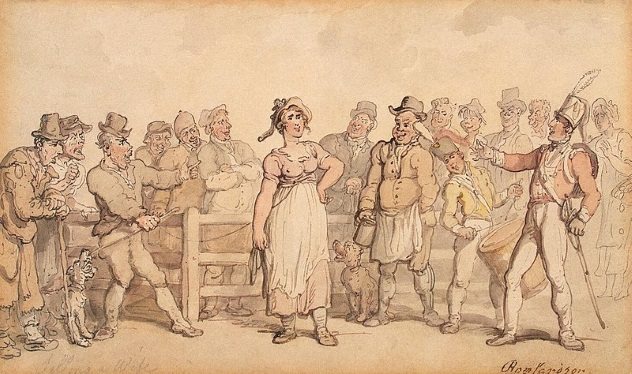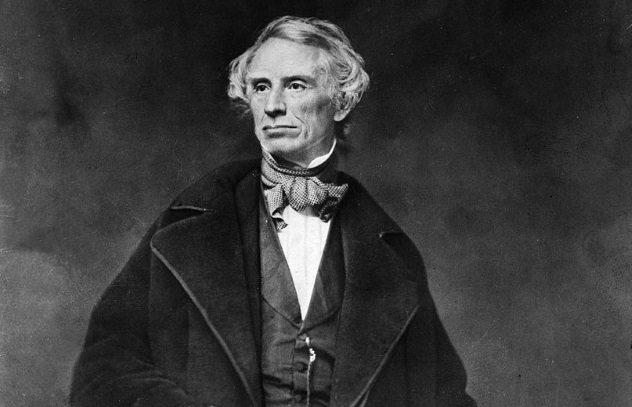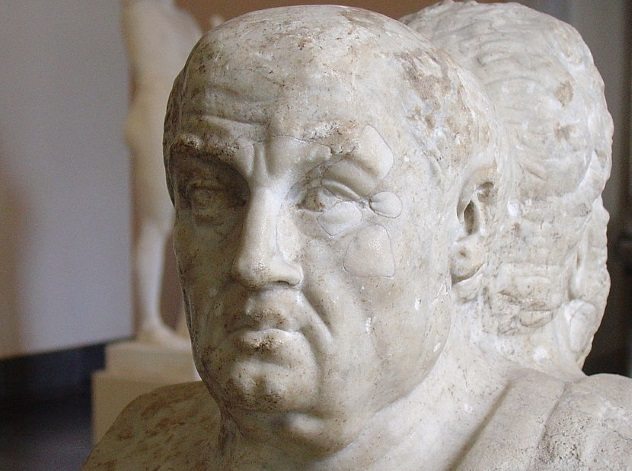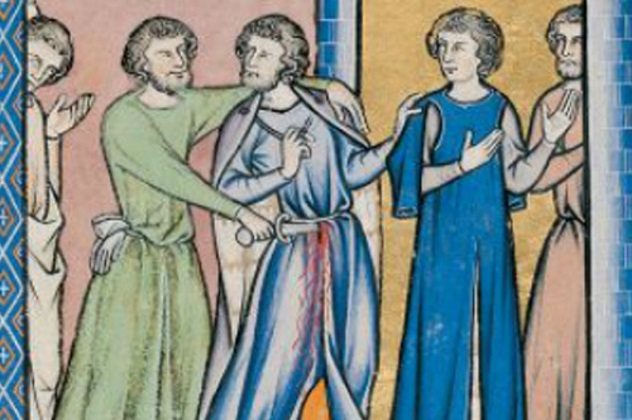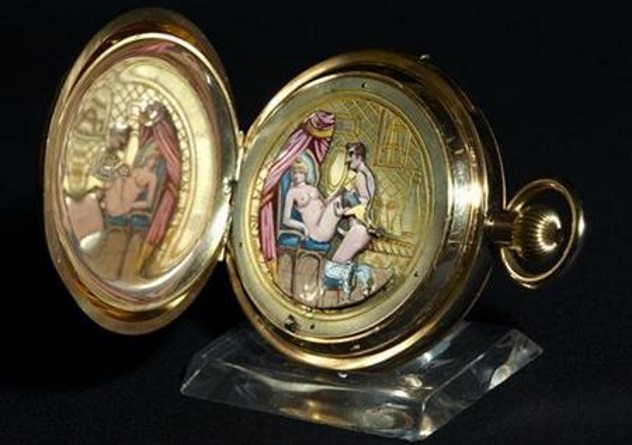No matter how many times we learn about the scandalous side of history, there’s always a bit more. And each time, it seems like we barely scratched the surface. Way too often, history books present a sanitized, clean version which is not only boring but also inaccurate.
10 Wives Were Sold In England During The Industrial Revolution
Industrial Revolution–era England had a lot of unhappy marriages, but divorce was a long and expensive process which wasn’t available to the lower classes. Therefore, they instituted a new tradition: wife selling. The concept appeared around the mid-1700s and became popular during the 19th century. This wasn’t an official procedure and never legally dissolved the marriage. However, most local magistrates were willing to look the other way, since both husband and wife had to agree on the sale. One of the most well-known and detailed instances of wife selling occurred on April 7, 1832, when a farmer named Joseph Thomson sold his wife in Carlisle. The event was presented in that year’s edition of The Annual Register and later published in Robert Chambers’s Book of Days, a popular compendium of curiosities, oddities, and anecdotes from British life. According to the account, Thomson walked into Carlisle and announced his intention to auction off his wife to the “highest and fairest bidder.” Once a large enough crowd gathered, he proceeded to present her faults and her virtues. All the while, the wife was seated on a large chair with a rope or halter around her neck. The auction lasted about an hour, and in the end, Thomson sold his wife to one Henry Mears for 20 shillings and a Newfoundland dog.[1] Chambers goes on to list numerous other examples of the practice, all the while critical of the ignorance of England’s rural population and the negative impression it created on their continental neighbors, particularly France.
9 Samuel Morse Hated Catholics And Immigrants
Samuel Morse is predominantly remembered today for his role in developing and commercializing the telegraph as well as the eponymous code it used to communicate. Not as well-remembered is his failed political career built on an anti-Catholic and anti-immigration platform. In 1834, Morse joined the growing Nativist movement and started writing a series of articles under the pen name “Brutus” decrying a Catholic conspiracy to destroy the American way of life. They were published by his brother, who was editor of the New York Observer at the time, and later turned into a book titled Foreign Conspiracy Against the Liberties of the United States. Morse’s biggest targets were poor immigrants coming from Ireland and Italy, who only brought with them ignorance and Roman Catholicism. Many of Morse’s friends and former admirers were shocked by his outspoken views, but he became a figurehead for the Nativist Party. In fact, they asked him to run as their mayoral candidate for New York City in 1836. Morse accepted but came in last.[2] However, this did allow him to dedicate his time to working on the telegraph.
8 Seneca’s Thoughts On Suicide
Seneca the Younger was a statesman and advisor to Nero. A follower of Stoicism, Seneca was also a prolific author. Among his best-known works was a collection of 124 letters titled Epistulae morales ad Lucilium —better known as the Moral Epistles—dealing with, as the name implies, moral issues. In letter 70, titled “On the Proper Time to Slip the Cable,” Seneca presented his thoughts on suicide. He was in favor of the practice, claiming, “A wise man will live as long as he ought, not as long as he can.” He preferred quality of years over quantity, and in his regard, dying well was better than living ill. Seneca went against other thinkers who opined that a man’s own destruction must be decreed by nature. He equated suicide to other techniques already used by man to relieve sufferings brought on by nature, such as cupping or bloodletting. Seneca went on to rail against the idea that you have to be a great man like Cato or Scipio to be able to take that final step. He presented the stories of two gladiators who went to extreme lengths to kill themselves rather than live as slaves. One of them was being carried in a cart with other prisoners. Pretending to fall asleep, he stuck his head over the side and trapped it in the spokes. Then, he braced tight so that the turn of the wheel broke his neck. The other gladiator was a German who was scheduled to fight wild beasts. Before the fight, he asked to go to the toilet, the only place where he wasn’t guarded. He found the only item available, which was a sponge on a stick that Romans used for wiping. He then shoved it down his throat and choked himself to death.[3]
7 Experts Destroyed A Priceless Sketch
As one of the most influential artists of all time, any work of Leonardo da Vinci is considered priceless. You can imagine people’s excitement back in the 1990s, when they discovered a previously unknown sketch of the Renaissance master, found among drawings of 17th-century printmaker Stefano della Bella. The sketch represented Orpheus being attacked by the Furies and was done for the production of Orpheus by contemporary playwright Poliziano. Special care had to be taken in order to preserve the sketch, so a team of restorers was brought in. And they immediately proceeded to destroy it by treating it with alcohol and water, causing the ink to fade.[4] Many scholars were dismayed at the blunder, questioning why the “experts” wouldn’t take the basic precaution of testing the ink for solubility before treating the entire sketch. Leading Leonardo expert Carlo Pedretti decided not to place fault or name names, hoping that the mistake could be reversed using technology.
6 Lewis And Clark’s Expedition Was Rife With Diarrhea And STDs
The Lewis and Clark Expedition is one of the most famous chapters in American history. Unsurprisingly, historians and fellow explorers have been keen to replicate the iconic trek from Missouri to the Pacific. However, the journey lasted 28 months and included over 600 sites. Even with the expedition journals and maps, locating all the stops has proven difficult. However, intrepid archaeologists found a unique way of identifying one campsite in Montana that belonged to the expedition: latrine analysis. If you’re wondering what made a Lewis and Clark latrine different from any other 200-year-old one, it was the high mercury content. According to their records, the explorers brought along plentiful supplies of Dr. Rush’s Bilious Pill—a very potent laxative.[5] One pill contained 10 grains of calomel, also known as mercurous chloride, and was so powerful that the pills were popularly referred to as “thunderclappers” or “thunderbolts.” The mercury-laced pills were also useful for another common affliction during the journey: syphilis. STDs were widespread among the 30-man expedition. So far, Traveler’s Rest in Montana is one of a handful of campsites located from that historical trek and the only one confirmed using physical evidence. However, in their journals, Lewis and Clark frequently mentioned team members purging for an entire day after taking the pills, so there should be plenty more “physical evidence” waiting to be dug up.
5 Benjamin Franklin Tried To Seduce A Friend’s Wife
Benjamin Franklin did a lot of outlandish things. While he was living in London, he tried to seduce the wife of a friend named James Ralph, as told by Franklin himself in his autobiography. According to him, Ralph and his new bride didn’t have enough money to start a family. Therefore, Ralph left London to teach at a country school in Berkshire and placed his wife in the care of Franklin. During that time, Ralph would often write Franklin, sending him pieces of an epic poem he was working on and asking for remarks. This annoyed Franklin, who tried to discourage the teacher’s artistic ambitions, but he replied nevertheless. In the meantime, Ralph’s wife (who Franklin refers to only as Mrs. T), often found herself in need of the Founding Father’s assistance. Over time, Franklin grew fond of her, and finding himself under no religious restraint, he “attempted familiarities.”[6] Mrs. T didn’t reciprocate his feelings and told her husband when he got back. Ralph broke off his friendship with Franklin and told him not to expect repayment of any debts. In the end, Franklin saw it as a positive. He didn’t care about being paid back since Ralph didn’t have the money anyway and regarded their broken friendship as a relief of burden because he wouldn’t receive any more poems.
4 University Violence Was Once Rife And Common
One of the first academic papers on the subject of university violence in medieval times was written by Professor Andrew Larsen of Marquette University, who examined the violent history of Oxford University. He identified four main categories of student violence. The first was personal conflict—violence between a few individuals based on personal issues between them. While many such instances resulted in beatings or stabbings, they were also the most poorly documented. “Town and gown violence” represented altercations between the students and the townsmen. These had often the potential for the most damage and could erupt into full-blown riots. That was the case in 1355 during the St. Scholastica Day Riot, which left almost 100 people dead, including over 60 scholars. The other two categories were northern-southern violence and faculty quarrels.[7] These were typically caused by conflict between nationalities or religions or were the result of elections. While the paper focused on Oxford, these incidents were common in other universities as well. Cambridge had a violent riot in 1381. In 1229, students from the University of Paris attacked and looted a tavern, and some were subsequently killed by city guardsmen. Larsen identified likely factors that contributed toward the violence. Most students were men between 14 and 21 years of age, had easy access to weapons, and were clerics and therefore protected by the benefit of clergy, which placed them outside the jurisdiction of secular courts.
3 Embalming And Necrophilia In Ancient Egypt
The ancient Egyptians were probably not the first to practice embalming, but they certainly kicked it up a notch. One of the first and most thorough accounts of the process as viewed by an outsider comes from Herodotus in his iconic work the Histories. The embalmers were all skilled laborers who practiced their craft as a business. According to Herodotus, they typically had three wooden corpses which served as models for their various services, depending on their clients’ budgets. The Greek historian went on to describe in intricate detail the workings of the most expensive, premium service, which involved scooping out the brain and rinsing the skull and then emptying, cleansing, and washing the abdomen before filling it up with spices and aromatics. Afterward, the body is left to sit for 70 days before being washed again, wrapped in fine linen, and delivered to the family. The medium package involved cedar tree oil being injected in the body and allowing it to liquefy the insides. The service for the poorer classes just involved clearing out the intestines and leaving the body to sit before the family came and picked it up. Although Herodotus glances over this bit, he mentions that dead beautiful women, especially the wives of high-ranking officials, were always left to sit three or four days before being brought for embalming.[8] This was so their bodies would start decaying and discourage the embalmers from necrophilia, or, as Herodotus put it, preventing “indignities from being offered them.”
2 Victorians Hid Erotic Images In Their Watches
Once people invented pocket watches, it didn’t take long for them to take the next logical step and create erotic pocket watches. Initially, it was customary for these timepieces to be commissioned with images of the owner’s wife or lover. Eventually, men got bored of that and wanted something a bit more titillating. The watches typically featured hand-painted, detailed, and graphic images, which were hidden behind the dials. This allowed men to carry their “pocket porn” discreetly and access it with the twist of a knob or the push of a button. The watches were created by master horologists and came with hefty price tags that placed them out of reach for most people. One recent auction of historical erotica was highlighted by the Musique D’amour: an extremely rare 1810 erotic pocket watch made by Swiss watchmaker Henry Capt, which sold for $220,000.[9]
1 Mass-Production Of Prints Brought Pornography
During the 15th century, printing advanced to the stage where low-quality images, often representing copies of paintings, could be mass-produced and then sold cheaply. This made them readily available to the lower classes, whereas beforehand, such works of art could only typically be afforded by the rich and kept in palaces away from public viewing. It didn’t take long before pornographic prints appeared. Given the huge influence of the Catholic Church at the time, printmakers took certain precautions to confer their works an air of classic artistry. They typically featured mythological beings like Roman gods or historical figures like Antony and Cleopatra. Perhaps the most notable erotic printmaker was Marcantonio Raimondi, who was actually imprisoned by Pope Clement VII for his obscene prints. He created I Modi (The Positions), a series of engravings, each one explicitly depicting a sexual position. They were paired with obscene sonnets written by poet Pietro Aretino, who also found himself in trouble with the Church and had to flee Rome. The Church confiscated Raimondi’s original drawings and destroyed all the prints they could find. No original prints survive today, but a “replacement set” was created by another printmaker, most likely Agostino Veneziano or Agostino Caracci. Nine fragments remain from these prints and can be found at the British Museum.[10] Other recreations were made in subsequent centuries, when there was less religious censorship.
